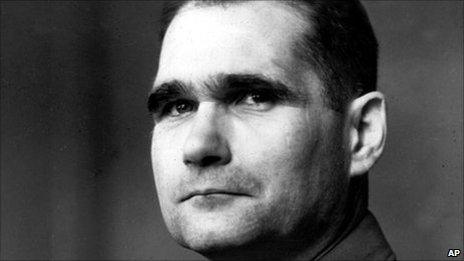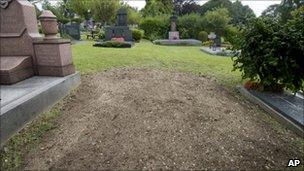The enduring myth of Rudolf Hess
- Published

On Wednesday 20 July 2011 - the anniversary of the attempt on Hitler's life in 1944 - the public was informed that the grave of Rudolf Hess, the "Fuehrer's deputy", had been razed before daybreak.
Beyond the fascinating coincidence in the date - there will surely be further speculation on this - the decision by Hess's heirs was surprising.
They wanted to commit his mortal remains to the waves and organise a funeral at sea for a man whose mystique and influence on the far-right was strongly linked to the existence of his grave in the Bavarian village of Wunsiedel.
He was already one the most interesting figures in post-war Germany, being the only high-ranking Nazi serving a life sentence imposed by the Nuremberg war-crimes court - Albert Speer, for instance, was released in 1966.
'Anti-German plot'
Hess owes his ambiguous fame to the circumstances of his death. He was found hanged in a summer house in Berlin's Spandau Prison, where he had spent the previous 20 years.
The official version - contested by right-wingers of all stripes - was that he committed suicide to end his long imprisonment.
For the German and international far-right movement, this was clear evidence that the powers that be had tried to suppress the truth about an "anti-German" plot dating back to the war years.
According to this version of events, the Allied forces - notably the British secret service - ignored the true purpose of Hess's flight to Britain in 1941. He was taking a peace plan to Churchill, he told his interrogators.
This idea made Hess the perfect figure to portray the Nazis as victims, rather than aggressors.
Britain had started World War II to destroy Germany, and Hess was captured in Scotland to crush the peaceful intentions of Nazi Germany.
Even the fact that Hitler declared him insane did not dent this legend.
Revitalised myth

The place where Rudolf Hess's grave once stood has been levelled
Moreover the resurgent Nazi scene in recent years has gradually recognised the potential of this myth to attract young people susceptible to tales of injustice.
What started as a tiny demonstration of a handful of Nazi activists in the 1990s had turned into thousands regularly filling the streets of Wunsiedel by early 2000s.
Everybody who looked at such scenes - including myself and my academic colleagues - felt uncomfortable. Most of the demonstrators were young and dressed like average heavy-metal kids - until you looked at their T-shirts and tattoos.
The Hess myth, modernised to satisfy a desire for victimhood, made the Wundsiedel commemorations alluring to young people. But it also led the Constitutional Court to ban the event in 2005, as the potential for the recruitment of new blood into the Neo-Nazi movement got increasingly obvious.
However the court order had limited effect on such gatherings, which continued less frequently and at a smaller scale elsewhere. But then Hess had become a kind of right-wing Che Guevara, with his portrait on shirts, buttons and posters.
In the end the family agreed to terminate the lease on the grave.
Thus an event that many would have thought highly improbably until now became reality on Wednesday evening. What might be the consequences of this startling decision?
Nazi zombie
Firstly, it is no coincidence that the relatives and officials chose to eliminate every physical trace of a figure with a vast potential for creating right-wing legends.
As was the case for Osama Bin Laden some weeks ago, the authorities understand the power of a permanent shrine to a highly controversial figure.
It becomes a place of pilgrimage, a focus for irrational and uncontrollable worship.
Secondly, the far-right movement has lost a crucial place embodying myths and legends that give it a friendly face. The neo-Nazis desperately need to celebrate the memory of an attractive "hero" for the benefit of new recruits.
And thirdly, there will be an increased potential for violence of all kinds - from street unrest to digital stalking - by the far-right.
Deprived of a leading rallying figure, the movement will feel that its noble tradition has been humiliated by unjust powers yet again.
Ultimately it is possible that a renewed cult could rise again around Hess, the ultimate Nazi zombie.
- Published21 July 2011
- Published4 May 2011
- Published10 May 2011
- Published23 October 2010